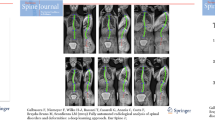Abstract
Finite element (FE) biomechanical studies for adolescent idiopathic scoliosis (AIS) treatments will greatly benefit from utilizing true-scale, patient-specific anatomy that accurately characterizes all tissue properties. This study presents a method to automatically generate patient-specific, FE meshes containing volumetric soft tissues, such as ligaments and cartilage, that are inconspicuous in computed tomography (CT) imaging of AIS patients. Convolutional neural network (CNN) derived vertebrae segmentations, obtained from CT scans, provide a foundation for subsequent elastic deformations of ligamentoskeletal, computer-aided designed (CAD) surface meshes, to ascertain patient-specific anatomy, including soft tissue structures. Patient-specific, ligamentoskeletal meshes are then tetrahedralized for use in FE studies. Dice similarity coefficients of 90% and submillimeter Hausdorff distances demonstrate vertebrae and intervertebral disc fitting accuracy of the automatic methodology. In severe AIS cases, when CNN segmentations fail due to overfitting, a semi-automatic step augments the automatic method. The generated FE meshes can provide the basis for biomechanical simulations seeking to correct AIS through bracing, minimally invasive operations, or patient-specific, surgical procedures, like posterior spinal fusion.
Access this chapter
Tax calculation will be finalised at checkout
Purchases are for personal use only
Similar content being viewed by others
References
Alliez, P., Cohen-Steiner, D., Yvinec, M., Desbrun, M.: Chapter 10: Variational tetrahedral meshing. In: ACM SIGGRAPH 2005 Courses, SIGGRAPH 2005 (2005)
Audette, M.A., et al.: Towards a deformable multi-surface approach to ligamentous spine models for predictive simulation-based scoliosis surgery planning. In: Zheng, G., Belavy, D., Cai, Y., Li, S. (eds.) CSI 2018. LNCS, vol. 11397, pp. 90–102. Springer, Cham (2019). https://doi.org/10.1007/978-3-030-13736-6_8
Cates, J., Elhabian, S., Whitaker, R.: ShapeWorks: particle-based shape correspondence and visualization software. In: Zheng, G., Li, S., Szekely, G. (eds.) Statistical Shape and Deformation Analysis, vol. 2017, pp. 257–298. Academic Press, MA (2017). Ch. 10
Cheung, Z. B., Cho, S.: Idiopathic scoliosis in children and adolescents: emerging techniques in surgical treatment. World Neurosurg. 130, e737–e742 (2019)
Damopoulos, D., Schmid, J.: Segmentation of the proximal femur in radial MR scans using a random forest classifier and deformable model registration. Int. J. Comput. Assist. Radiol. Surg. 14(3), 545–561 (2019)
Guan, T., Zhang, Y., et al.: Determination of three-dimensional corrective force in adolescent idiopathic scoliosis and biomechanical finite element analysis. Front. Bioeng. Biotechnol. 8, 963 (2020)
Guerroumi, N., Playout, C., et al.: Automatic segmentation of the scoliotic spine from MR images. In: International Symposium on Biomedical Imaging, vol. 2019, pp. 480–484 (2019)
Illés, T., Somoskeöy, S.: The EOSTM imaging system and its uses in daily orthopaedic practice. Int. Orthop. 36, 1325–1331 (2012)
Korez, R., Likar, B., Pernuš, F., Vrtovec, T.: Model-based segmentation of vertebral bodies from mr images with 3D CNNs. In: Ourselin, S., Joskowicz, L., Sabuncu, M.R., Unal, G., Wells, W. (eds.) MICCAI 2016. LNCS, vol. 9901, pp. 433–441. Springer, Cham (2016). https://doi.org/10.1007/978-3-319-46723-8_50
La Barbera, L., Aubin, C.E.: In silico patient-specific optimization of correction strategies for thoracic adolescent idiopathic scoliosis. Clin. Biomech. 81, 105200 (2021)
Little, J.P., Adam, C.: Patient-specific computational biomechanics for simulating adolescent scoliosis surgery: predicted vs clinical correction for a series of six patients. Int. J. Numer. Methods Biomed. Eng. 27(3), 347–356 (2011)
Lenke, L.G., Blanke, K.: Adolescent idiopathic scoliosis. A new classification to determine extent of spinal arthrodesis. J. Bone Joint Surg. 83(8), 1169–1181 (2001)
Mohamed, M., Trivedi, J., Davidson, N., Munigangaiah, S.: Adolescent idiopathic scoliosis: a review of current concepts. Orthop. Trauma 34(6), 338–345 (2020)
Payer, C., Urschler, M.: Integrating spatial configuration into heatmap regression based CNNs for landmark localization. Med. Image Anal. 54, 207–219 (2019)
Rajaee, M.A., Arjmand, N., Shirazi-Adl, A.: A novel coupled musculoskeletal FE model of the spine – critical evaluation of trunk models. J. Biomech. 119, 110331 (2021)
Wang, W., Baran, G.R., Cahill, P.J.: The Use of finite element models to assist understanding and treatment for scoliosis: a review paper. Spine Deformity 2(1), 10–27 (2014)
Author information
Authors and Affiliations
Corresponding author
Editor information
Editors and Affiliations
Rights and permissions
Copyright information
© 2021 Springer Nature Switzerland AG
About this paper
Cite this paper
Tapp, A. et al. (2021). Generation of Patient-Specific, Ligamentoskeletal, Finite Element Meshes for Scoliosis Correction Planning. In: Oyarzun Laura, C., et al. Clinical Image-Based Procedures, Distributed and Collaborative Learning, Artificial Intelligence for Combating COVID-19 and Secure and Privacy-Preserving Machine Learning. DCL PPML LL-COVID19 CLIP 2021 2021 2021 2021. Lecture Notes in Computer Science(), vol 12969. Springer, Cham. https://doi.org/10.1007/978-3-030-90874-4_2
Download citation
DOI: https://doi.org/10.1007/978-3-030-90874-4_2
Published:
Publisher Name: Springer, Cham
Print ISBN: 978-3-030-90873-7
Online ISBN: 978-3-030-90874-4
eBook Packages: Computer ScienceComputer Science (R0)





